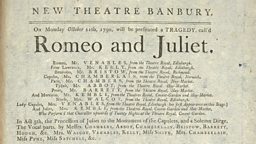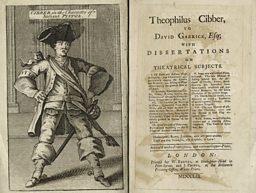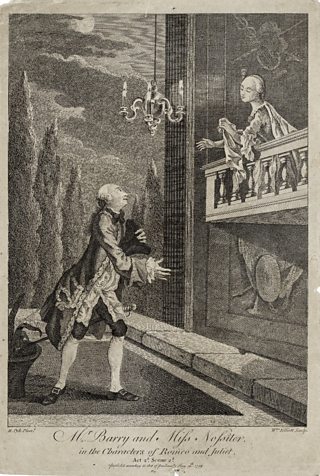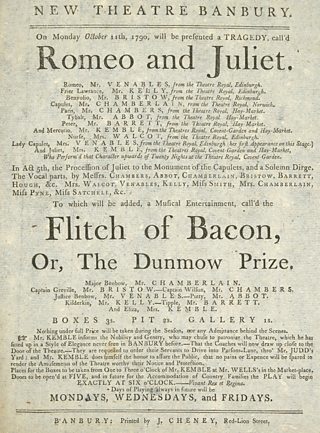Smash hit Shakespeare in Banbury’s elegant theatre
On Monday 11th October 1790, audiences were treated to Romeo and Juliet in a lovely new theatre. Kemble has assembled something of an all-star cast for this production and wants Banbury to know it, as each actor has a prestigious theatre attached to their name on the playbill.
This cast includes the well-known actor fresh from Edinburgh’s Theatre Royal, Mr Venables as Romeo, and Mrs Kemble, who has married into the most famous acting family of the era, as Juliet, a role she has performed numerous times at London’s Covent Garden theatre.
-
![]()
Much ado near me
Hear more Shakespeare stories on BBC Radio Oxford
-
![]()
Shakespeare Festival 2016
The BBC celebrates the genius of the bard

This actress is Elizabeth Satchell (1763–1841) who married the actor manager George Stephen Kemble in 1783. She acted with him for several years, and of the two she was felt to be the greater talent, but her career played second fiddle to his. When her husband’s engagements took him out of London, she accompanied him.
There were several different adaptations of Romeo and Juliet – this one was probably a popular version by David Garrick which played up the sentiment of the lovers’ final embrace before death.
It features 'the Procession of Juliet to the Monument of the Capulets, and a Solemn Dirge' in Act 5 - this was originally created for a performance in 1750 at Covent Garden to draw audiences. The intention was to lure audiences away from David Garrick's adaption which was running at Drury Lane. It was so popular that Garrick quickly inserted his own version of funeral scene with dirge, and it is performed on this evening in Banbury.
Star-crossed adaptations
The story of Shakespeare’s star-crossed lovers Romeo and Juliet has been a smash hit ever since it was first written. In fact there is a note on the title page of the 1597 edition of the play which says: "it hath been often (with great applause) plaid publiquely".
In the Bard’s time, the play would have been acted on a bare-stage and with a minimum of props.
The balcony at the end of the stage would be Juliet’s bedroom and a trapdoor would signify her tomb.
After the restoration of Charles II to the throne, the play was performed for a brief time on the stage at Lincoln’s Inn Fields in London in 1662 by the actor-manager William Davenant.
In 1679, Thomas Otway adapted Romeo and Juliet and this version reigned on stage for about the next seventy years. He set the play which was entitled The History and Fall of Caius Marius in ancient Rome and renamed the lovers Marius and Lavinia. The play highlighted political issues of state and it’s believed this reflected the real-life crisis dominating the country who would succeed to the throne.
In 1744, Theophilus Cibber played Romeo in a version closer to the original, but it still retaining some of Otway's additions, such as Juliet waking before Romeo dies for a final impassioned speech. Extracts from another of Shakespeare's plays, The Two Gentlemen of Verona, were added. Cibber’s casting was controversial as his daughter played opposite him. At the time Cibber was in his early forties, while his Juliet was just 14.
It seems that audiences did not like this casting. A version which fared better was David Garrick's Romeo and Juliet, staged at Drury Lane in 1748, to much greater success. He removed many of Shakespeare’s bawdy jokes and sexual references, with the result that the role of Mercutio was reduced. He also read his audiences desire for sentimentality and inserted a scene between Romeo and Juliet in the tomb before they die. His version of the play was the standard text for the stage for the next 100 years or so.

Rival Romeos
40 years before this production, two leading actors in two rival productions duelled for audiences in London.

The actor Spranger Barry had been alternating lead roles such as Hamlet and Macbeth with the famous David Garrick. But his success as Romeo proved too much for the actor manager and Barry left the company in 1750 for a rival production at Covent Garden, taking his 'Juliet', Susannah Cibber with him.
With David Garrick himself taking the title role at Drury Lane, the two were in direct competition.
Barry was the more ardent Romeo; whereas Garrick best embodied the tragic nature of the role.
Audiences could compare the performances for themselves by enjoying Barry’s impassioned wooing at Covent Garden for the first half of the play before visiting Drury Lane to see Garrick die tragically in the second.
The Royal Shakespeare Company website carries a quote from a female fan who captures the differences between the two performances:
"Had I been Garrick's Juliet – so impassioned was he, I should have expected that he would have come up to me on the balcony; but had I been Juliet to Barry's Romeo – so tender and seductive was he, I should certainly have jumped down to him!"
Where was the theatre in Banbury?
This playbill relates to a period when larger towns in the English provinces had a patent theatre.
By 1790 this list included Bath, York, Hull, Norwich, Liverpool, Manchester, Chester, Bristol, Margate, Newcastle, Bristol and Norwich.

Performances in smaller places were at the discretion of local magistrates who could licence these entertainments for up to 60 days at a time. We do not know where this particular production was staged, but we know the drop-off point for the local gentry was in Parson’s Lane through Mr Judd’s yard.
Curtain up is at six o’clock, possibly because rural folk went to bed early compared with more fashionable society in the capital. It may also be on account of the dangers of travelling along dark country roads late at night.

Banbury Cross Players on Shakespeare in the new theatre (Image credit: Yale Center for British Art/Paul Mellon Collection)
Linda Shaw from the acting company discusses the all-star performance of Romeo and Juliet
About Shakespeare on Tour
From the moment they were written through to the present day, Shakespeare’s plays have continued to enthral and inspire audiences. They’ve been performed in venues big and small – including inns, private houses and emerging provincial theatres.

BBC English Regions is building a digital picture which tracks some of the many iconic moments across the country as we follow the ‘explosion’ in the performance of The Bard’s plays, from his own lifetime to recent times.
Drawing on fascinating new research from Records of Early English Drama (REED), plus the British Library's extensive collection of playbills, as well as expertise from De Montfort University and the Arts and Humanities Research Council, Shakespeare on Tour is a unique timeline of iconic moments of those performances, starting with his own troupe of actors, to highlights from more recent times. Listen out for stories on Shakespeare’s legacy on your BBC Local Radio station from Monday 21 March, 2016.
You never know - you might find evidence of Shakespeare’s footsteps close to home…
Craig Henderson, BBC English Regions
Related Links
Shakespeare on Tour: Around Oxford
-
![]()
Shakespeare's company perform Othello in Oxford
Shakespeare himself was acting around this time
-
![]()
Can this be the famous Shakespearean actor Edmund Kean performing in an Oxford pub?
Or is there more to this than meets the eye?
Shakespeare on Tour: Around the country
-
![]()
The 1809 ticket price riots
The most famous riots in the history of theatre
-
![]()
Cambridge students put on a Christmas satire
Shakespearean style 'Footlights'
-
![]()
North West's influence on Shakespeare's success
Plus, the small Cheshire town that attracted Shakespeare's players
-
![]()
Salisbury shadows play Shakespeare
A dreamy performance of Shakespeare








